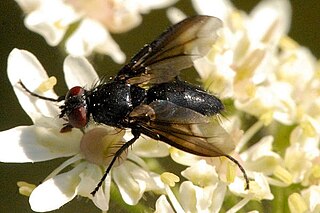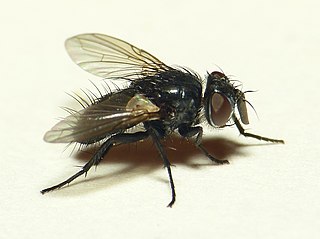
The Tachinidae are a large and variable family of true flies within the insect order Diptera, with more than 8,200 known species and many more to be discovered. Over 1300 species have been described in North America alone. Insects in this family commonly are called tachinid flies or simply tachinids. As far as is known, they all are protelean parasitoids, or occasionally parasites, of arthropods, usually other insects. The family is known from many habitats in all zoogeographical regions and is especially diverse in South America.
Actinochaetopteryx is a genus of tachinid flies in the family Tachinidae. Its members occur in the Palaearctic, Oriental, and Australasian realms. The type species is Actinochaetopteryx actifera, from Taiwan.

Blondelia is a genus of flies in the family Tachinidae.

Campylocheta is a genus of flies in the family Tachinidae.

Catharosia is a genus of flies in the family Tachinidae. There are about 12 described species in Catharosia, found worldwide.
Formosia is a genus of parasitic flies in the family Tachinidae.
Mycteromyiella is a genus of parasitic flies in the family Tachinidae. There are about five described species in Mycteromyiella.

Rutilia is a large genus of medium to large (>20mm) flies in the family Tachinidae native to Australia and the Oriental region, though notably absent from New Zealand. Like the vast majority of tachinid flies, Rutilia species are parasitoids of other insects, specifically Rutilia are known to be parasitoids of late instar larvae of scarab beetles.

Senostoma is a genus of parasitoid tachinid flies in the family Tachinidae. Endemic to Australasia, the flies are medium-sized, bristly, and long-legged.

Trigonospila is a small genus of parasitic flies in the family Tachinidae.

Dexiinae is a subfamily of flies in the family Tachinidae.

Exoristinae is a subfamily of flies in the family Tachinidae.

Blondeliini is a tribe of parasitic flies in the family Tachinidae. Larvae are parasitoids of other insects, mostly beetles and caterpillars. Although nearly cosmopolitan, its greatest diversity is in the New World and especially in South America.

Compsilura is a genus of tachinid flies in the family Tachinidae from Mozambique, Malawi and South Africa.
Zosteromeigenia mima is a species of fly in the family Tachinidae and the sole representative of the genus Zosteromeigenia. Like the vast majority of tachinid flies, Z. mima is expected to be a parasitoid of other arthropods, likely the larvae of Lepidoptera, however few or no host records exist.
Acemyini is a small but cosmopolitan tribe of flies in the family Tachinidae. Like all tachinid flies, acemyiines are parasitoids of other invertebrates. Specifically, the acemyiines are parasitoids of Orthoptera in the families Acrididae and Eumastacidae.
Anagonia is a genus of flies in the family Tachinidae.
Amphibolia is a genus of bristle flies in the family Tachinidae.
Formodexia is a genus of bristle flies in the family Tachinidae.
Nardia is a genus of parasitic flies in the family Tachinidae.










